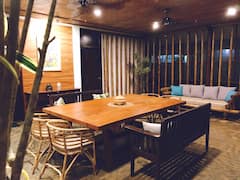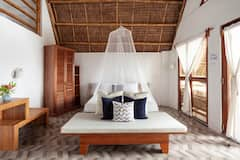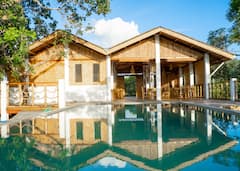Twice hailed by Travel and Leisure magazine as the “Best Island in the World,” Palawan is every beach-lover’s dream that has come to life. The pristine island, sometimes known as the “Last Ecological Frontier of the Philippines,” welcomes visitors with long stretches of white sand beaches, as well as limestone mountains jutting out of turquoise waters that are home to unique underwater species.
If you’re up for a one-of-a-kind nature trip, there’s no need to think twice before heading to this island. Pack your beach essentials and read this list of the best things you should experience when in Palawan.
1. Visit the Puerto Princesa Underground River
Puerto Princesa Underground River, a UNESCO World Heritage Site, is one of the first things you will hear if you ask a local where to go in Palawan. Also known as one of The New 7 Wonders of Nature, this 8.2-kilometer (5.1-mile) river is considered as the longest navigable underground river in the world. The cave itself is made up of limestone karsts and is filled with stalactites and stalagmites. Its biggest chamber is called the “Italian’s Chamber”, which spans 360 meters (1,181 feet). Apart from its stunning natural formations, the Puerto Princesa Underground River is also popular for its diverse animal species including 195 bird species, 19 reptiles, and 30 mammals.
Puerto Princesa Subterranean River National Park
Address: Puerto Princesa, Palawan
Price: from 23 USD
Opening Hours: 9 am - 6 pm. Closed on public holidays
Duration: around 3 hours required
Access: Boat ride from Sabang Bay
Contact: (02) 523 6023
2. Enjoy diving at Tubbataha Reef
Tubbataha Reef was once ranked by the CNN travel website as one of the Top Eight Dive Sites in the World. Discovered by divers in the 1970s, it covers a total area of 10,000 hectares (24,710 acres) filled with rich marine biodiversity. There are over 600 species of fish that have found their home in Tubbataha, as well as a number of manta rays, sharks, dolphins, whales and the already endangered green sea turtles. The whole stretch of the Tubbataha Reef is a protected area and, although sport diving is allowed, visitors are highly encouraged to follow safe diving practices to avoid damaging the corals. The best time for diving in Tubbataha is from mid-March until mid-June.
3. Have fun exploring Palawan’s Twin Beach
Nacpan and Calitang Beach are together known as the “Twin Beach” of El Nido in Palawan. The roads leading to these beaches are not yet fully developed, but the beauty of the scenery is surely worth the bumpy ride. The beaches boast white sand and cool blue waters, as well as shaded spots where you can relax with a local drink or a book in one hand. If privacy is an important factor to you when choosing a vacation spot, these beaches are perfect for you. Since Nacpan and Calitang are not yet mainstream travel destinations, you can sometimes enjoy them to yourself, especially during weekdays. In any case, they are less crowded than other beaches. Meanwhile, for a breathtaking view of the Twin Beach, you can hike up the small hill where the beaches meet. For backpackers or DIY travelers, the best way to reach the Twin Beach is by renting a tricycle or an auto-rickshaw.
You might be interested in these Airbnbs!
4. Try kayaking at Barracuda and Kayangan Lake
Coron, a first-class municipality in Palawan, is home to seven enchanting lakes. However, only two of these lakes are open to the public: the Kayangan Lake and Barracuda Lake. Kayangan is said to be the cleanest lake in the Philippines, boasting clear blue waters surrounded by limestone karsts. It is ideal for families, since its waters are shallow and even kids can try snorkeling. Meanwhile, Barracuda Lake has deeper waters. It is famous among divers because of the marine animals found there, including the barracuda after which the lake was named. You can rent a boat to explore both of these lakes, but if you’re up for more adventure, you can rent a kayak instead.
Palawan (Province) Tour Guide
Leila Eldian
Welcome to the Philippines. I am Leila, Tourguide/Tour management company Entrepreneur/ English-Japanese Interpreter. I am a Mass Communication graduate. My varied professional journeys in customer service, airline, media & tourism expertise plus the passion in handcrafting journeys of a lifetime; will make your experiences more fun & meaningful.
Palawan (Province) Tour Guide
Rosalyn Capablanca
From Palawan Paradise, greetings! Hello, my fellow nomads! Your guide to Palawan, the Last Frontier, is me, Rosa! I live in a tropical oasis surrounded by luscious flora and blue lakes. Together, let me be your ticket to paradise as we discover Palawan's wonders.Palawan is well known for its breathtaking islands, each with an individual allure. The most well-known locations are Puerto Princesa,... Read more
5. Enjoy island hopping at Honda Bay
Honda Bay is a popular day-trip destination for travelers coming from Puerto Princesa. Just a 45-minute ride away from the city proper, the bay has four pristine islands, namely Luli Island, Starfish Island, Pandan Island, and Cowrie Island. The best way to explore all of these islands is to join an island-hopping tour, which usually includes land and boat transfers, as well as services of a tour guide. Since it has beautiful reefs and aquarium fish, Honda Bay is also a popular snorkeling destination. You can bring your own snorkeling gear, but in case you can’t, there’s a number of stalls in the area offering equipment rentals.
6. Soak in the Big and Small Lagoons

The Big and Small Lagoons are El Nido’s most popular kayaking destinations. Both are picture-perfect, with limestone cliffs and calm waters ideal for paddling. The entrance to the Small Lagoon is not accessible for regular-sized boats, but can be reached by kayak. Meanwhile, the Big Lagoon is best explored on an outrigger boat. Both lagoons serve as breeding grounds for various fish species and crustaceans. Various studies by scientists have revealed that the Big and Small Lagoons were once covered by caves that collapsed millions of years ago.
7. Experience firefly watching at the Iwahig River

Nature trips in Palawan don’t end at sun down. At night, you can enjoy a firefly watching tour at the Iwahig River, a 10-meter-long (33-foot-long) stream dotted with mangroves and other native trees. On such tours, guests are transferred to small boats with a tour guide. They paddle for approximately 30 to 45 minutes, with stops to marvel at the beauty of fireflies lighting up the trees. The Iwahig River is the most ideal place to watch these lightning bugs since it is far from the city’s light pollution. Flash photography is prohibited during the tour because this might disturb the fireflies.
8. Be in awe of the majestic Tabon Caves
The Tabon Caves in Palawan is a 138-hectare (341-acre) archaeological museum where a significant number of 50,000-year-old artifacts were recovered. The most popular archaeological discovery from this area is called the Tabon Man, or the remains of the oldest known human in the Philippines. A total of 30 caves have already been mapped and explored by archaeologists, but only seven of them are open for public viewing. Guests are also advised to drop by the National Museum branch at Poblacion, Quezon for briefing before proceeding to the Tabon Caves via a 30-minute pump boat ride.
9. Have a thrilling adventure at Ugong Rock

The Ugong Rock, a geologic formation in Puerto Princesa, is a destination recommended for thrill-seekers. It is named after the local word “ugong”, which refers to the echoing sound that the area’s rocks produce when they are tapped. There are two kinds of activities you can do at Ugong Rock: caving and ziplining. Rock caving involves climbing up steep rocks and moving through narrow passages inside a cave. The whole course takes approximately 40 minutes. Upon reaching the top of Ugong Rock, guests can ride the zipline to go back to the starting point. Helmets and gloves are provided for the safety of guests. It’s certainly an awesome adventure!
Ugong Rock
Address: Barangay Tagabinet, Puerto Princesa, Palawan
Price: from 10 USD
Opening Hours: 8 am - 5 pm
Duration: around 3 hours required
Access: 20 kilometers (12.4 miles) from Sabang Village
Traveler's tips
Nature enthusiasts and thrill seekers will love Ugong Rock Adventures. This place has karst limestones that existed for millions of years. What makes this place extra special is that its income goes back to its trained local staff, who are also farmers from the community. Once you arrive at the reception area, a tour guide will brief you about precautionary measures when doing activities here. However, you don’t have to worry, since there is provided safety gear and tour guides will assist you. While in the cave, you will be in awe of the stunning stalagmite and stalactite formations and will have fun climbing using bamboo stairs, ropes, and a harness. Moreover, the peak of the cave will allow you to enjoy the rice field vistas and ride a 350-meter (1,148-feet) zip line to go down.
10. Be mesmerized with the view from Taraw Cliff
Who says Palawan isn’t for hikers? Taraw Cliff, the highest peak of El Nido, is a huge limestone karst that visitors can climb to enjoy the panoramic views of the whole town. The best time for a climb is during the early morning, from 7 am to 9 am. Be sure to wear durable shoes and be mindful of the sharp rocks scattered everywhere. As much as possible, visitors are advised to take their time in climbing. Upon reaching the summit and taking in the stunning views, you will surely understand why people still climb up Taraw despite the difficulty of the trail to its summit.
11. Witness rich wildlife at Calauit Wildlife Sanctuary

Filipinos are lucky because there’s no need for them to go out of their country for a safari adventure. They have the Calauit Wildlife Sanctuary in Palawan, a 3,700-hectare (9,143-acre) island that is home to endemic Palawan species of flora and fauna, as well as exotic African animal varieties. Some of the animals you will find here are giraffes, monkeys, zebras, Calamian deers, crocodiles, and bear cats. The park offers tour packages that include the services of a tour guide, the use of a tour vehicle, and a short lecture about wildlife conservation.
12. Learn about the Philippine Crocodiles at Palawan Wildlife Rescue and Conservation Center
Palawan Rescue and Conservation Center is another wildlife destination you shouldn’t miss. Formerly known as the Crocodile Farming Institute, it serves as a refuge for the endemic Philippine Crocodiles. They help in restoring the health of sick and disabled crocodiles, and they conduct further research for the conservation of these animals. The center also features a mini-zoo where other endemic animals from Palawan are kept. If you wish to see how crocodiles are fed, come on a Monday or Thursday afternoon. It is only a 30-minute ride from the city proper. You can rent either a tricycle or a jeep to take you to the crocodile farm, depending on the size of your group.
Palawan Wildlife Rescue and Conservation Center
Address: National Road, Puerto Princesa
Price: from 1 USD
Opening Hours: 8.30 am - 4.30 pm
Duration: around 3 hours required
Access: a two-minute jeep / tricycle ride from the city proper
Contact: (048) 433 2968
13. Unwind and relax at Palawan Butterfly Ecological Garden and Tribal Village
Combining an environmental and a cultural experience, the Palawan Butterfly Ecological Garden and Tribal Village is among the most popular destinations for inland tours in Puerto Princesa. The ecological garden showcases a variety of butterfly species, as well as other endemic and endangered Palawan creatures. It is a great opportunity to learn about environmental awareness for both kids and kids at heart. Meanwhile, at the Tribal Village, guests will get to meet indigenous people who gladly share trivia about their traditional musical instruments and hunting tools. They can also demonstrate the primitive way of making a bonfire by using only a bunch of stones.
Palawan Butterfly Ecological Garden and Tribal Village
Address: Santa Monica, Puerto Princesa
Price: from 1 USD
Opening Hours: 8.30 am - 5.00 pm
Duration: around 3 hours required
Access: a 30-minute ride from the city proper
Contact: +63917 597 5544
Website: Palawan Butterfly Ecological Garden and Tribal Village
14. Check out Iwahig Prison and Penal Farm

A prison doesn’t sound much of a tourist attraction but in Palawan, there’s a prison with a penal farm that has become a popular destination among travelers over the years. Managed by the Bureau of Corrections, the facility allows inmates to work in the fields and make handicrafts to sustain their livelihood. Some inmates from the minimum security prison even serve as tour guides. Iwahig Prison has been lauded several times for its efforts to prepare the inmates for transitioning back to their normal lives after their sentence, instead of just letting them rot away inside the cells. Don’t forget to check out the Recreation Hall, where souvenirs made by the inmates themselves are available for purchase.
15. Take some photos at the Karst Mountain Elephant Cave

Karst Mountain Elephant Cave is reminiscent of the rock formations in Krabi, Thailand. Since this place is just beside the main road and near Cabayugan and Sabang, it is a famous stopover destination for tourists heading to Ugong Rock Adventures and Puerto Princesa Subterranean River National Park.
It is a monolith of limestone with surrounding rice fields and topped with lush vegetation. There are also two small nipa huts here where guests take photos. Moreover, this rock formation is near Cleopatra’s Needle—an equally beautiful mountain. Though the interiors of the cave are not yet accessible, tourists flock to this place to unwind and take Instagrammable photos. It was even featured in the Amazing Race Philippines. Just make sure that your tour operators have secured a permit if you want to get closer to the area.
16. Shop and roam around Baker’s Hill and Mitra’s Ranch
Once you’ve seen Palawan’s gorgeous beaches and stunning limestone karsts, it’s time to relax and unwind at Baker’s Hill or Mitra’s Ranch. Baker’s Hill is a small park in Puerto Princesa that is famous for its shop selling delicious baked goodies. Included on their menu are hopia, bean-filled pastries, and ensaymada, a sweet bread sprinkled with grated cheddar cheese on top. You may enjoy these freshly-baked items as you wander around Baker Hill’s well-manicured gardens. Nearby is Mitra’s Ranch, owned by the family of a former Philippine senator. It has a viewing deck offering a great view of Puerto Princesa city, a zipline, and an area where horses and cows are taken care of.
More reasons to love Palawan
Palawan has everything a beach-lover can ask for: fine white sand, turquoise waters, and limestone mountains. In terms of biodiversity, it’s safe to say that it is one of the richest places in the Philippines. What most travelers do not know is that this island, which has a total area of 1,489,655 hectares (3,681,018 acres), is also home to three major indigenous communities: the Batak, the Tagbanua, and the Pala’wan.
The well-preserved culture makes Palawan even more interesting, while the locals’ warmth in welcoming visitors is truly admirable. From the tour guides and boatmen to simple individuals who are always ready to greet visitors with a smile on their face, isn’t it great to know that every person who has lived here for years is glad to share their majestic hometown with the rest of the world?
Map Location
History
Get Trip101 in your inbox
Unsubscribe in one click. See our Privacy Policy for more information on how we use your data


















































Create an account to